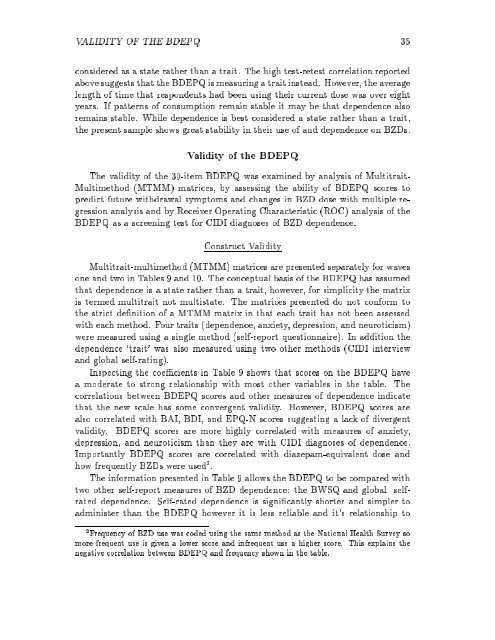Manual for the Benzodiazepine Dependence Questionnaire (BDEPQ)
Manual for the Benzodiazepine Dependence Questionnaire (BDEPQ)
Manual for the Benzodiazepine Dependence Questionnaire (BDEPQ)
You also want an ePaper? Increase the reach of your titles
YUMPU automatically turns print PDFs into web optimized ePapers that Google loves.
VALIDITY OF THE <strong>BDEPQ</strong> 35<br />
considered as a state ra<strong>the</strong>r than a trait. The high test-retest correlation reported<br />
above suggests that <strong>the</strong> <strong>BDEPQ</strong> is measuring a trait instead. However, <strong>the</strong> average<br />
length of time that respondents had been using <strong>the</strong>ir current dosewas over eight<br />
years. If patterns of consumption remain stable it may be that dependence also<br />
remains stable. While dependence is best considered a state ra<strong>the</strong>r than a trait,<br />
<strong>the</strong> present sample shows great stability in <strong>the</strong>ir use of and dependence on BZDs.<br />
Validity of <strong>the</strong> <strong>BDEPQ</strong><br />
The validity of <strong>the</strong> 30-item <strong>BDEPQ</strong> was examined by analysis of Multitrait-<br />
Multimethod (MTMM) matrices, by assessing <strong>the</strong> ability of <strong>BDEPQ</strong> scores to<br />
predict future withdrawal symptoms and changes in BZD dose with multiple regression<br />
analysis and by Receiver Operating Characteristic (ROC) analysis of <strong>the</strong><br />
<strong>BDEPQ</strong> as a screening test <strong>for</strong> CIDI diagnoses of BZD dependence.<br />
Construct Validity<br />
Multitrait-multimethod (MTMM) matrices are presented separately <strong>for</strong> waves<br />
one and two inTables 9 and 10. The conceptual basis of <strong>the</strong> <strong>BDEPQ</strong> has assumed<br />
that dependence is a state ra<strong>the</strong>r than a trait, however, <strong>for</strong> simplicity <strong>the</strong> matrix<br />
is termed multitrait not multistate. The matrices presented do not con<strong>for</strong>m to<br />
<strong>the</strong> strict de nition of a MTMM matrix in that each trait has not been assessed<br />
with each method. Four traits (dependence, anxiety, depression, and neuroticism)<br />
were measured using a single method (self-report questionnaire). In addition <strong>the</strong><br />
dependence `trait' was also measured using two o<strong>the</strong>r methods (CIDI interview<br />
and global self-rating).<br />
Inspecting <strong>the</strong> coe cients in Table 9 shows that scores on <strong>the</strong> <strong>BDEPQ</strong> have<br />
a moderate to strong relationship with most o<strong>the</strong>r variables in <strong>the</strong> table. The<br />
correlations between <strong>BDEPQ</strong> scores and o<strong>the</strong>r measures of dependence indicate<br />
that <strong>the</strong> new scale has some convergent validity. However, <strong>BDEPQ</strong> scores are<br />
also correlated with BAI, BDI, and EPQ-N scores suggesting a lack ofdivergent<br />
validity. <strong>BDEPQ</strong> scores are more highly correlated with measures of anxiety,<br />
depression, and neuroticism than <strong>the</strong>y are with CIDI diagnoses of dependence.<br />
Importantly <strong>BDEPQ</strong> scores are correlated with diazepam-equivalent dose and<br />
how frequently BZDs were used 2 .<br />
The in<strong>for</strong>mation presented in Table 9 allows <strong>the</strong> <strong>BDEPQ</strong> to be compared with<br />
two o<strong>the</strong>r self-report measures of BZD dependence: <strong>the</strong> BWSQ and global selfrated<br />
dependence. Self-rated dependence is signi cantly shorter and simpler to<br />
administer than <strong>the</strong> <strong>BDEPQ</strong> however it is less reliable and it's relationship to<br />
2 Frequency of BZD use was coded using <strong>the</strong> same method as <strong>the</strong> National Health Survey so<br />
more frequent use is given a lower score and infrequent use a higher score. This explains <strong>the</strong><br />
negative correlation between <strong>BDEPQ</strong> and frequency shown in <strong>the</strong> table.


